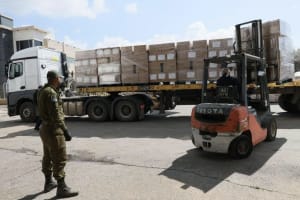Up to 80% of Hamas terror tunnels reportedly still intact despite over 100 days of intense fighting

The Wall Street Journal (WSJ) reported on Sunday that Israeli and U.S. officials estimate up to 80% of Hamas’ terror tunnel network below Gaza could still be operational, despite more than 100 days of intense combat and significant Israeli forces stationed in Gaza.
An unnamed Israeli official told the WSJ that between 20% to 40% of the terror group’s network could be destroyed, or at least no longer operational. Even if the more optimistic estimate is correct, this still leaves around 60% of the tunnels intact.
The Hamas tunnel network plays a critical role in the Iranian-backed terror group’s multi-front war against Israel. The network is used for hiding senior Hamas commanders, weapons and arms factories, in a vast underground city. The terrorists are also believed to be keeping the remaining 130 Israeli hostages in these subterranean locations.
Known for its nickname, the “Gaza Metro,” the vast tunnel network is believed to extend for some 300 miles (500 km) below the compact Gaza Strip that measures only 365 square km (141 square miles, which is about six times the size of Manhattan). By comparison, London’s Underground tube network is around 250 miles long.
The WSJ report emerges as the IDF is engaged in “high-intensity fighting” in Khan Younis, a key Hamas stronghold. Israeli media reported earlier this month that the IDF had eyes on Hamas military leader Yahya Sinwar, but was unable to perform a precision strike because he had surrounded himself with hostages, deep underground.
The Hamas tunnel network has long been used to smuggle both large quantities of weapons and terrorists – notably ISIS members – across the border between the Egyptian Sinai and the key Gazan border town Rafah.
Richard Goldberg, senior advisor for the Foundation for Defense of Democracies (FDD) – an American think tank focused on national security – criticized Washington for ignoring Iran’s considerable efforts to smuggle weapons into Gaza through tunnels on the Egyptian border.
“The United States has long turned a blind eye to Iranian smuggling through Egypt to arm, equip and train Hamas. Like everything post-October 7, we need a reset on how we view the Egyptian-Gaza border and how we will work with the Egyptians to shut down illicit smuggling routes,” Goldberg assessed.
Hamas’ vast tunnel network has also enabled the terror group to quickly transport weapons and fighters between various locations in the Gaza Strip, surprising IDF troops operating in the area. Much of the tunnel system extends below civilian infrastructure, including such as hospitals, schools, mosques and residential buildings.
In December, the Israeli military reportedly began pumping seawater into the tunnels in an attempt to damage the vast subterranean network, however, the operation is considered risky and time consuming as Israeli authorities must first examine specific portions of tunnels to make sure they are clear of Israeli hostages.
In 2015, Egypt used this tunnel-flooding technique against some smuggling tunnels near the border close to Rafah. Some believe that in order to effectively neutralize the Hamas network, Israel will likely need to capture the border town of Rafah and the Philadelphi corridor, a narrow buffer zone on the Egyptian-Gaza border. However, Cairo does not want Israeli forces so close to its border.
Egyptian authorities recently warned Jerusalem that bilateral ties would be at risk if Israeli forces entered the sensitive border areas. However, according to reports, Israel has already informed Cairo of its intention to send troops to the area, amid deteriorating Egyptian-Israeli ties. While Jerusalem says it understands Cairo’s concerns, it stressed its own security interests, just as Egypt focuses on its own interests.

The All Israel News Staff is a team of journalists in Israel.













